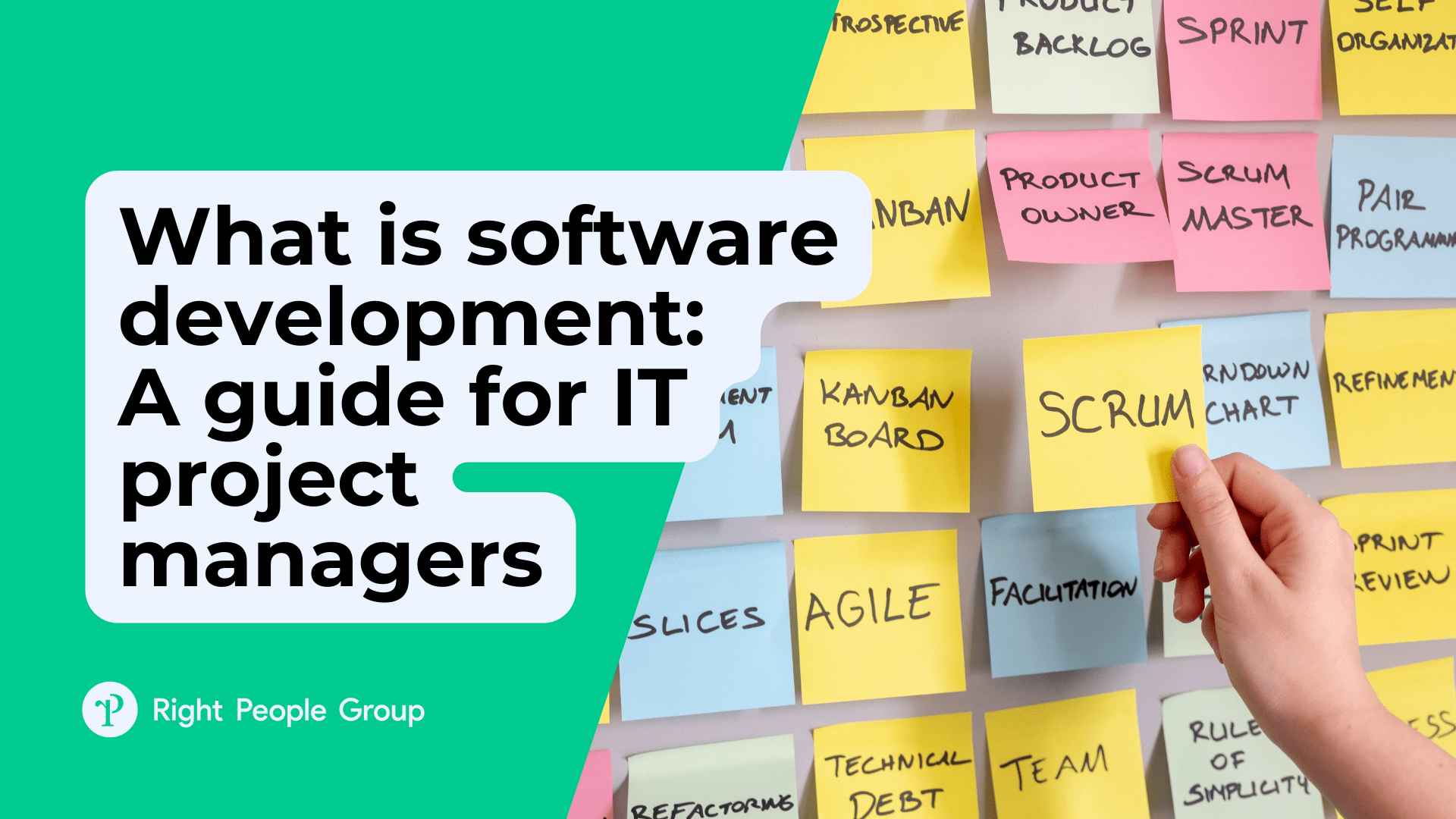Software is everywhere. It’s what makes our apps work, our computers run, and our businesses thrive.
The software development process is a series of steps that go from planning to coding, testing, and maintaining software.
If you’re an IT project manager, knowing the ins and outs of this process is key to your success. This article will give you a straightforward guide to what software development is, why it matters, and how to manage it well.
The role of an IT project manager in software development
In software development, the project manager is the captain of the ship. Your role is multi-faceted and centers on making sure the project not only gets done but gets done well.
- Communication: You’re the main point of contact between the tech people and the business folks. Clear communication helps avoid misunderstandings and keeps everyone in the loop.
- Planning and timelines: You set the schedule and make sure everyone sticks to it. This involves breaking down the project into tasks and setting deadlines.
- Resource allocation: Knowing who is good at what helps you assign the right tasks to the right software developer. This ensures the work gets done efficiently.
- Quality and risk management: You’re also in charge of making sure the software meets all the quality standards. Plus, if any issues might slow down the project, it’s your job to find solutions.
- Stakeholder management: One of your key responsibilities is to manage the expectations of stakeholders, which can include everyone from team members and executives to clients and end-users. This involves regular updates, managing expectations, and being the go-to person for any project-related queries.
Your role is to keep the project on course and make sure everyone involved knows what they need to do and when. You’re the glue that holds the project together, ensuring it meets its goals while keeping an eye on quality and timelines.
Key phases of software development
The Software Development Life Cycle (SDLC) serves as a roadmap for building high-quality software.
It outlines the key phases that guide a project from its initial concept to its final deployment and ongoing maintenance.
Understanding each phase is necessary for project managers, developers, and stakeholders alike to ensure a successful software development project.
Requirements gathering
Requirements gathering is where project managers can shine by asking the right questions and setting clear expectations.
This phase involves detailed discussions to clarify the scope and objectives of the project.
Design and planning
Once the requirements are clear, the next step is to plan how to meet them. Software design involves creating a blueprint for the developers to follow. This phase often includes selecting the programming languages and frameworks that will be used.
Implementation (coding)
After planning comes the action part: coding. This is where software developers work their magic, turning design plans into functional software. Programming languages like Python, Java, and C++ are commonly used. The development team collaborates to write the code that will become the final software program.
Testing
Before any software is deployed, it must be rigorously tested to ensure it meets all requirements and is free from bugs. Software engineers often use automated testing tools alongside manual testing to cover all bases.
Deployment
Once the software has passed all tests, it’s time for deployment. This phase involves making the software available to users. Depending on the project, this could mean launching a mobile app on various platforms or rolling out system software across an organization.
Maintenance
The software development lifecycle doesn’t end with deployment. Continuous improvement is necessary to adapt to user feedback and emerging technologies. Maintenance involves regular updates, bug fixes, and possibly adding new features.
Methodologies in software development
Knowing different software development methods helps project managers talk the same language as their teams. This makes it easier to plan, make smart choices, and manage risks. In short,
if you’re a project manager, understanding these methods is a key part of doing your job well.

Waterfall model
The Waterfall model is one of the original approaches to software development. It’s a step-by-step process where you finish one phase completely before moving on to the next.
Here’s why some teams still use it:
- Clear structure: The Waterfall model is easy to understand. You have a set plan and you stick to it, which can be great for clients who want to know exactly what to expect.
- Detailed documentation: Because each phase is completed fully before moving on, there’s usually detailed documentation. This can be helpful for future reference or if the project changes hands.
- Risk and uncertainty: If you know exactly what needs to be done and how, the Waterfall model can be a safe bet. There’s less room for error when you’ve planned everything out in detail.
However, it’s not great for projects where you might need to make changes along the way. Once you’ve completed a phase, it’s hard to go back and make adjustments.
Agile methodology
Agile methodologies is the go-to for many modern software development projects. Unlike Waterfall, Agile lets you make changes and improvements as you go along.
Here’s why it’s popular:
- Flexibility: Agile allows for changes even late in software development processes. If you get user feedback or face unexpected challenges, you can pivot easily.
- Client involvement: Clients can see progress in real-time and give feedback, making sure the end product is what they actually want.
- Faster to market: Because you’re developing in cycles, you can get a working version of the software faster, even if it’s not the final version.
Agile is often the better choice for projects where user needs might change, or when you’re developing something completely new and might need to adjust as you learn more.
Other methodologies
There are also hybrid or specialized methodologies like Scrum and Kanban. These are variations that combine elements of both Waterfall and Agile.
- Scrum: This is a type of Agile that’s organized around “sprints,” short periods of work where specific tasks are completed. It’s good for keeping teams focused and for projects that need frequent reassessment.
- Kanban: This method focuses on continuous delivery and doesn’t have set phases or cycles. It’s more fluid and allows for constant changes. It’s often used for projects that require ongoing maintenance or updates.
- Feature-Driven Development (FDD): This is a model-driven, short-iteration process that was built around software engineering best practices such as domain modeling, developing by feature, and code ownership. It’s more rigid than Agile but not as restrictive as Waterfall.
The best methodology for your project really depends on what you’re trying to achieve, how your team works best, and what your clients expect. Each has its own strengths and weaknesses, so understanding them helps you pick the right one for your project.
Tools of the trade
Understanding the tools commonly used in software development can make a world of difference in how efficiently and effectively a project is managed.
Here’s a breakdown of some of the key tools:
Project management software
When it comes to keeping everything organized, project management software is your best friend.
- Task management: Software like Jira and Asana lets you assign tasks to team members, set deadlines, and even prioritize work.
- Timeline tracking: These tools allow you to set up timelines or sprints, helping you keep an eye on the project’s progress.
- Collaboration: Features like comment sections, file attachments, and real-time updates make it easier for everyone to stay on the same page.
In short, project management software helps you keep the project organized, on track, and ensures everyone is aligned on their roles and responsibilities.
Integrated development environments (IDEs)
For the developers on your team, an IDE is where they spend most of their day.
- Code writing: IDEs like Visual Studio and Eclipse have features that speed up the coding process, like auto-complete and error detection.
- Testing: Built-in testing tools let developers check their work as they go, making it easier to catch issues early.
- Debugging: When problems do arise, a good IDE can help pinpoint the issue, saving valuable time.
IDEs streamline the coding process, making it easier and faster for developers to write, test, and debug code.
Version control
Keeping track of changes is important, especially when multiple people are working on the same project.
- Collaboration: Version control systems like Git allow multiple developers to work on the same project without stepping on each other’s toes.
- History: If something goes wrong, you can look back at previous versions to find out what changed and when.
- Branching and merging: These features allow developers to work on new features or fixes in isolation, then integrate them back into the main project when they’re ready.
Version control is the safety net and collaboration hub for your code. It allows for smooth teamwork and provides a backup of your project’s history.
Each of these tools serves a specific purpose in the software development process, and understanding how to leverage them can significantly improve your project management skills.
Challenges and how to overcome them
You’re likely to encounter a variety of challenges that can throw a wrench in your plans. But don’t worry, there are ways to tackle these issues head-on.
- Scope creep: This happens when the project’s requirements start to grow beyond what was originally planned. The key is to have a well-defined scope from the start and to stick to it. If changes are necessary, make sure they’re approved and documented.
- Budget overruns: Money can quickly become a problem if not managed carefully. Keep a close eye on expenditures and have a contingency plan for unexpected costs.
- Team conflicts: When people work closely, disagreements are bound to happen. Address conflicts early through open dialogue and try to find a solution that everyone can live with.
- Quality issues: No one wants to deliver a subpar product. Regular testing and quality checks can help catch issues before they become major problems.
- Missed deadlines: It’s common for projects to fall behind schedule, and this can have a domino effect on other aspects like budget and quality. Effective time management and regular progress checks can help keep the project on track.
Conclusion
Understanding what software development is and how the process works is extremely important for IT project managers. From the initial requirements gathering to the final deployment, each phase is integral to developing high-quality software. Familiarity with software development methodologies and tools can further enhance a project manager’s effectiveness.
Looking for project management consultants?
Searching for a project management consultant capable of steering your software development projects to success?
Since 2007, Right People Group has been the trusted source for top-tier IT and business consultants. We rigorously pre-screen each consultant in our network, selecting only those who blend a track record of high performance with competitive rates.
Reach out to Right People Group today, and we’ll connect you with the ideal project management consultant tailored to your project’s specific needs.













